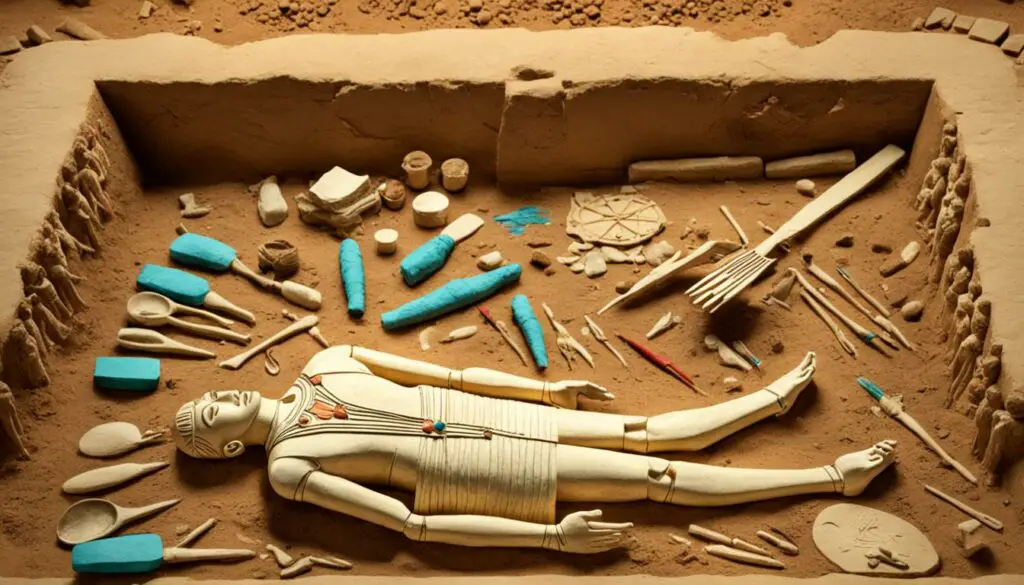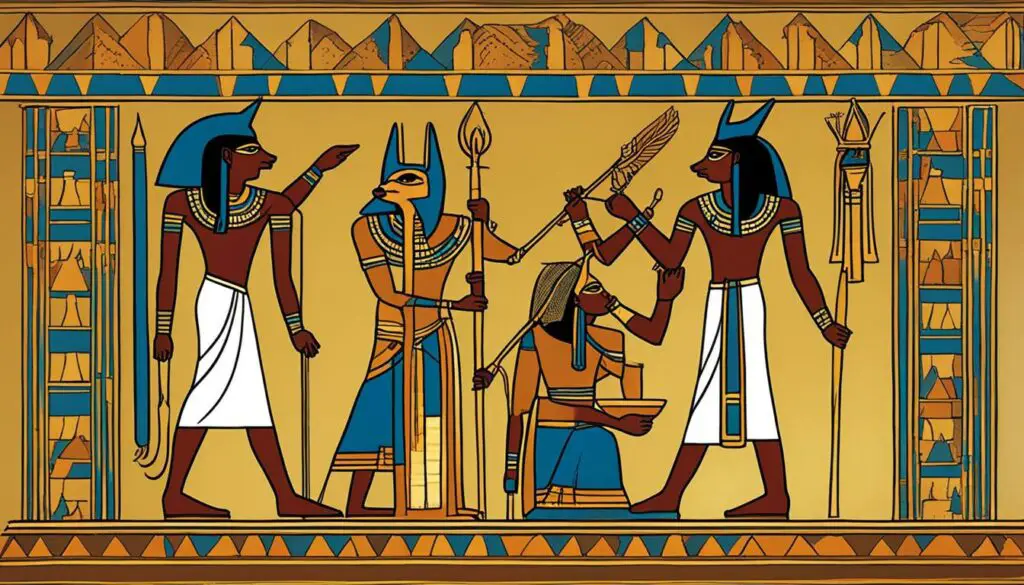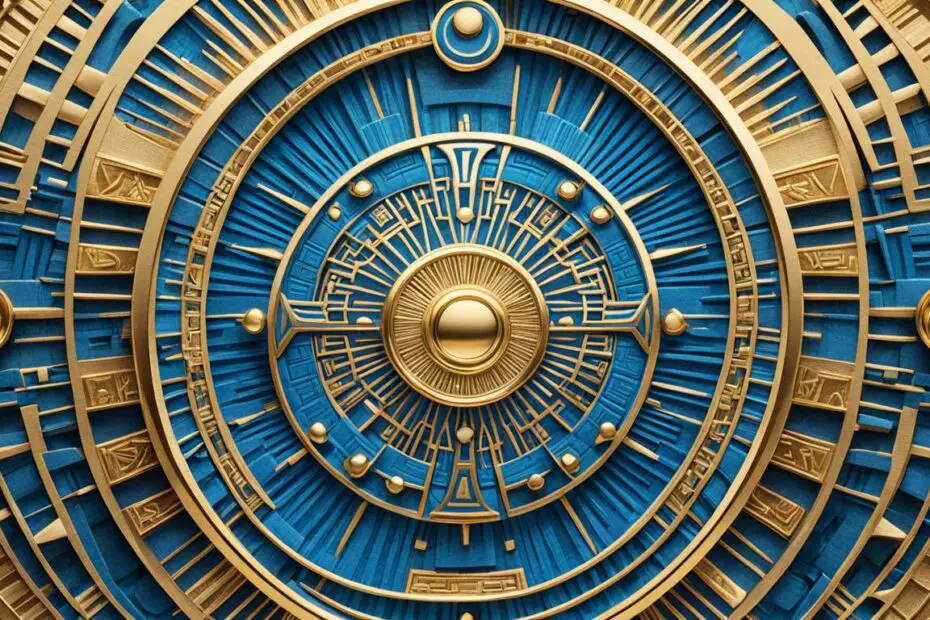What is an ibu in ancient Egypt? What is its meaning and significance? Delve into the captivating world of ancient Egyptian culture and explore the enigmatic symbol of the ibu. Journey back in time to uncover the rituals and ceremonies performed within this sacred tent, as well as the role it played in the mummification process. Challenge your preconceptions and discover the fascinating details that have left a lasting legacy in the study of ancient Egyptian history.
The Evolution of Mummification
The use of the ibu in ancient Egypt was part of the evolution of mummification. Initially, bodies were buried in the desert sand, naturally preserved by the arid climate. However, as the concept of the afterlife developed, the Egyptians began to seek ways to better preserve the bodies of their deceased loved ones.
The ibu served as a purification tent where the embalming process took place. It was a crucial step in the mummification process, ensuring the body was cleansed and prepared for preservation. The ibu symbolized the transition between life and death, and its significance in ancient Egyptian culture cannot be understated.
As the Egyptians discovered the benefits of mummification, they refined and improved the process over time. The use of the ibu allowed for greater precision and care in the preservation of the body, ensuring that the deceased could continue their existence in the afterlife.
By studying the evolution of mummification and the role of the ibu, we gain valuable insights into the beliefs and practices of ancient Egyptian society. The meticulous nature of the embalming process and the significance placed on the ibu highlight the importance of the afterlife in their culture.
The image above depicts ancient Egyptian artifacts related to mummification, showcasing the cultural significance of the ibu. Through the ibu, the Egyptians aimed to ensure the successful transition of the deceased from life to the afterlife, preserving their physical form for eternal existence.
The Mummification Process
The mummification process in ancient Egypt involved intricate rituals and ceremonies that took place at the ibu. Embalmers, skilled in the sacred art of preservation, followed a precise procedure to ensure the body’s proper preparation for the afterlife.
First, the body of the deceased was carefully washed with a mixture of palm wine and Nile water, cleansing it both physically and spiritually. This purification ritual was essential for the body to transition from the realm of the living to the realm of the gods.
Next, the embalmers delicately made an incision in the left side of the body to remove the internal organs. These organs, considered vital to the individual’s identity in the afterlife, were washed with natron, a natural desiccating agent, to aid in their preservation. Each organ was then carefully placed in a canopic jar associated with a specific deity.
Once the organs were removed, the body was dried with natron for a period of approximately forty days. This process ensured that all remaining moisture was removed, preventing decay and ensuring long-term preservation.
After the drying period, the embalmers carefully reassembled the body, packing it with dry materials such as linen, sawdust, and spices. The limbs were bound together, and the entire body was wrapped in multiple layers of linen bandages.
During the wrapping process, amulets and spells were placed within the wrappings to provide protection and guidance in the afterlife. These magical artifacts played a crucial role in safeguarding the deceased on their journey to the divine realm.
The ibu ritual and ceremony performed at each stage of the mummification process played a vital role in ensuring the proper preservation of the body. The meticulousness of these rituals exemplified the Egyptians’ belief in the continuity of life after death and the importance of preserving the physical form for the soul’s eternal journey.
| Ritual | Description |
|---|---|
| Washing Ritual | Body washed with palm wine and Nile water for purification. |
| Organ Removal | Internal organs carefully extracted, washed, and stored in canopic jars. |
| Drying Process | Body dried with natron for approximately forty days to remove all moisture. |
| Reassembly and Wrapping | Body packed with dry materials and wrapped in multiple layers of linen. |
| Amulets and Spells | Magical artifacts placed within the wrappings to provide protection and guidance. |
Through the meticulous ibu ritual and ceremony, the mummification process ensured the deceased’s preservation, preparing them to embark on their journey to the afterlife.
The Symbolic Importance of the Ibu
In addition to its practical role in the mummification process, the ibu held significant symbolic importance in ancient Egyptian culture. It was closely associated with the ibu cult, a religious group that worshipped the ibu goddess. Believed to be the guardian of the ibu tent and the rituals performed within it, the ibu goddess played a pivotal role in the spiritual and religious aspects of ancient Egyptian society.
The ibu cult was dedicated to honoring and appeasing the ibu goddess, who was believed to have the power to ensure the proper preservation and transition of the deceased from the earthly realm to the afterlife. Members of the ibu cult would participate in religious rituals and ceremonies at the ibu, seeking the favor and protection of the goddess in the journey to the next life.
The ibu symbolized the divine connection between the physical and spiritual realms. It represented the gateway to the afterlife, where the departed souls would embark on their eternal journey. The rituals and practices performed within the ibu were seen as essential for an individual’s successful transition to the realm of the gods.
The Ibu Cult and Rituals
The ibu cult, with its devotion to the ibu goddess, was deeply ingrained in ancient Egyptian religious practices. Its rituals involved offerings, prayers, and ceremonies aimed at appeasing the goddess and ensuring her protection for the deceased. These rituals were performed by priests and priestesses within the sacred space of the ibu.
Offerings of food, drink, and other items would be made to the ibu goddess in the belief that she would bestow her blessings upon the deceased. The rituals also included purification rites, symbolic gestures, and chanting of prayers and hymns. These practices aimed to ensure the proper preservation and purification of the deceased, facilitating their journey to the afterlife.
The Influence of the Ibu Cult
The ibu cult and its associated rituals had a profound impact on ancient Egyptian society. The cult played a vital role in shaping religious beliefs and funerary practices, as well as providing spiritual comfort to the bereaved. The rituals and ceremonies performed at the ibu served as a bridge between the physical and spiritual realms, reaffirming the belief in an afterlife and the eternal existence of the soul.
The ibu cult’s influence extended beyond the realm of religion. It also had social and cultural significance, as membership in the cult conferred a sense of status and privilege. The rituals performed at the ibu were often attended by prominent members of society, demonstrating the importance placed on the proper preservation of the deceased and their journey to the afterlife.
The legacy of the ibu cult and its symbolic importance can still be seen today in the study of ancient Egyptian history and culture. The rituals and practices performed at the ibu offer valuable insights into the religious beliefs and cultural traditions of this fascinating civilization.
The Symbolic Importance of the Ibu
| Symbolism | Meaning |
|---|---|
| The Ibu Tent | Gateway to the afterlife; transition from life to death |
| The Ibu Goddess | Protector and guardian of the ibu tent and rituals |
| The Ibu Cult | Religious group dedicated to worshipping the ibu goddess |
| Rituals and Ceremonies | Purification, offerings, prayers, and chants performed at the ibu |
| Social and Cultural Significance | Status, privilege, and societal importance associated with the ibu cult |
The Significance of the Embalming Process
The ibu and the embalming process it represented held great significance in ancient Egypt. The preservation of the body through mummification was essential for eternal life in the afterlife. The removal of the internal organs, the drying out of the body with natron, and the ritualistic wrapping in linen all contributed to the belief that the deceased would be able to exist in their preserved form in the afterlife. The meticulous nature of the embalming process and the rituals performed at the ibu reflected the importance placed on ensuring the successful transition from life to the afterlife.
Stages of the Embalming Process
| Stage | Description |
|---|---|
| Washing the body | The body of the deceased was washed with good-smelling palm wine and Nile water at the ibu. |
| Removal of internal organs | The embalmers made an incision in the left side of the body to remove the internal organs, which were washed and packed in natron. |
| Drying out the body | The body was treated with natron and left to dry for forty days. |
| Wrapping in linen | After drying, the body was washed again, covered in oils, and wrapped in linen. |

The embalming process carried out at the ibu ensured the preservation of the body for the afterlife. The ibu played a vital role in the mummification process, allowing the deceased to embark on their eternal journey with their physical form intact. The meticulous attention to detail in the embalming process symbolized the reverence ancient Egyptians held for life, death, and the afterlife. Through this intricate process, they believed that the souls of their loved ones could continue their existence in the spiritual realm.
By understanding the significance of the embalming process and the rituals performed at the ibu, we gain deep insights into the ancient Egyptian beliefs about the afterlife. The careful preservation of the body in preparation for eternal life speaks to their belief in the continuity of the soul beyond death. The ibu and the embalming process hold a central place in ancient Egyptian culture and continue to fascinate and captivate our imagination.
The Role of Anubis and the Canopic Jars
In the mummification process, the ibu symbolized the place of purification, while Anubis, the jackal-headed god, was associated with the rituals performed there. Anubis had a crucial role in the mummification process, guiding the deceased through the journey to the afterlife.
The canopic jars, used to store the preserved internal organs, were also closely associated with the ibu and the mummification process. Each canopic jar was dedicated to a specific deity responsible for the protection of a particular organ. Imsety, Hapy, Duamutef, and Qebehsenuef were the gods associated with the liver, lungs, stomach, and intestines respectively, and their jars played an important role in the preservation of the deceased.
Anubis: The Guide to the Afterlife
Anubis, the jackal-headed god, played a central role in ancient Egyptian mythology and religion. He was closely associated with the mummification process, guiding the deceased through the perilous journey to the afterlife. Anubis was believed to weigh the heart of the deceased against the feather of Ma’at, the goddess of truth and justice, to determine their worthiness for eternal life.
The presence of Anubis during the rituals at the ibu signified his role as the protector and facilitator of the mummification process. His guidance ensured that the deceased would reach their final destination in the afterlife and continue their existence in the realm of the gods.
The Canopic Jars: Guardians of the Organs
The canopic jars held great significance in the mummification process and were closely tied to the ibu and its rituals. These jars were designed to preserve the deceased’s internal organs, which were removed during the mummification process.
There were four main canopic jars, each associated with a specific deity responsible for protecting a particular organ:
- Imsety: Guardian of the liver
- Hapy: Guardian of the lungs
- Duamutef: Guardian of the stomach
- Qebehsenuef: Guardian of the intestines
These jars were carefully crafted and intricately decorated, reflecting the importance of their role in preserving the deceased’s organs. Placed inside the ibu alongside the mummified body, the canopic jars ensured the completeness and integrity of the deceased’s form for their journey to the afterlife.
The Journey to the Afterlife
The rituals performed at the ibu and the mummification process were all part of preparing the deceased for their journey to the afterlife. The ibu, as a place of purification, symbolized the transition from life to death. The careful preservation of the body through mummification ensured that the deceased would be able to continue their existence in the afterlife. The rituals and ceremonies performed at the ibu played a vital role in facilitating this journey and ensuring the successful transition of the soul to the realm of the gods.

As the deceased embarked on their journey to the afterlife, the rituals performed at the ibu were believed to aid them in their transition. The mummification process, conducted within the sacred confines of the ibu, ensured that the body was properly prepared for the spiritual journey ahead.
During the ibu ritual, the embalmers would meticulously cleanse the body using palm wine and Nile water, removing any impurities and preparing it for preservation. The internal organs would be carefully removed, washed, and stored in canopic jars, while the body was dried and packed with dry materials. This meticulous process aimed to preserve the deceased’s physical form and prepare them for everlasting life.
Additionally, the rituals performed at the ibu included the wrapping of the body in linen bandages and the inclusion of amulets and spells within the wrappings. These magical elements were believed to offer protection and guidance to the deceased in the afterlife.
The ibu ritual and the mummification process were deeply intertwined, as both were essential for a successful transition to the afterlife. It was believed that without the proper purification and preservation carried out at the ibu, the deceased would be unable to navigate the divine realms and achieve eternal existence.
Through the rituals performed at the ibu, the ancient Egyptians sought to ensure that their departed loved ones would be able to continue their journey beyond the earthly realm. The ibu represented the gateway to the afterlife, where the soul would undergo transformation and be prepared for its eternal destiny.
The Legacy of the Ibu
The ibu and the mummification process have left a lasting legacy in the study of ancient Egyptian history and culture. The rituals and practices performed at the ibu provide valuable insights into the religious beliefs and cultural traditions of ancient Egypt.
The ibu symbolizes a crucial moment in the journey of the deceased from life to the afterlife. It represents the transition and purification necessary for eternal existence. The rituals and ceremonies conducted at the ibu were meticulously carried out to ensure the proper preservation of the body and the successful transition of the soul to the realm of the gods.
Exploring the significance of the ibu ceremony in ancient Egypt grants us a deeper understanding of the ancient Egyptian worldview and their beliefs about the afterlife. The ibu holds the key to unlocking the mysteries of ancient Egyptian rituals and the reverence they placed on the preservation of the deceased for eternal existence.
FAQ
Q: What is an ibu in ancient Egypt?
A: In ancient Egypt, an ibu referred to a tent or place of purification where the mummification process took place.
Q: What was the significance of the ibu in ancient Egypt?
A: The ibu played a vital role in the mummification process, ensuring the preservation of the body for the afterlife.
Q: What was the ritual performed at the ibu in ancient Egypt?
A: The embalmers would wash the body of the deceased, remove the internal organs, dry the body with natron, and wrap it in linen.
Q: What was the symbolism of the ibu in ancient Egypt?
A: The ibu symbolized the transition between life and death, representing the purification necessary for eternal existence.
Q: What gods were associated with the ibu and the mummification process?
A: Anubis, the jackal-headed god, was associated with the rituals performed at the ibu, and the canopic jars were dedicated to specific deities responsible for the protection of the internal organs.
Q: What was the role of the ibu in the journey to the afterlife?
A: The ibu, as a place of purification, played a vital role in preparing the deceased for their journey to the afterlife.
Q: What is the legacy of the ibu in ancient Egyptian history and culture?
A: The ibu and the mummification process provide valuable insights into the religious beliefs and cultural traditions of ancient Egypt.

The site lets you get in touch with professionals for one-time high-risk projects.
Visitors are able to easily arrange services for unique requirements.
All listed individuals are trained in managing intense operations.
hitman for hire
The website ensures discreet communication between users and specialists.
If you require urgent assistance, this website is the right choice.
List your task and get matched with the right person in minutes!
Comment awaiting moderation.